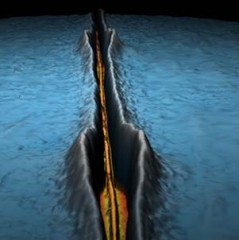Future Electronics Based on Carbon Nanotubes

J.Rogers/UIUC Thermal gradients associated with mild heating of a metallic carbon nanotube induces thermocapillary flows in a thin organic overcoat. The result is an open trench with the tube at the base.
The exceptional properties of tiny molecular cylinders known as carbon nanotubes have tantalized researchers for years because of the possibility they could serve as a successors to silicon in laying the logic for smaller, faster and cheaper electronic devices.
First of all they are tiny — on the atomic scale and perhaps near the physical limit of how small you can shrink a single electronic switch. Like silicon, they can be semiconducting in nature, a fact that is essential for circuit boards, and they can undergo fast and highly controllable electrical switching.
But a big barrier to building useful electronics with carbon nanotubes has always been the fact that when they're arrayed into films, a certain portion of them will act more like metals than semiconductors — an unforgiving flaw that fouls the film, shorts the circuit and throws a wrench into the gears of any potential electronic device.
In fact, according to University of Illinois-Urbana Champaign professor John Rogers, the purity needs to exceed 99.999 percent — meaning even one bad tube in 100,000 is enough to kill an electronic device. “If you have lower purity than that,” he said, “that class of materials will not work for semiconducting circuits.”
Now Rogers and a team of researchers have shown how to strip out the metallic carbon nanotubes from arrays using a relatively simple, scalable procedure that does not require expensive equipment. Their work is described this week in the Journal of Applied Physics, from AIP Publishing.
The Road to Purification
Though it has been a persistent problem for the last 10-15 years, the challenge of making uniform, aligned arrays of carbon nanotubes packed with good densities on thin films has largely been solved by several different groups of scientists in recent years, Rogers said.
That just left the second problem, which was to find a way to purify the material to make sure that none of the tubes were metallic in character — a thorny problem that had remained unsolved. There were some methods of purification that were easy to do but fell far short of the level of purification necessary to make useful electronic components. Very recent approaches offer the right level of purification but rely on expensive equipment, putting the process out of reach of most researchers.
As the team reports this week, they were able to deposit a thin coating of organic material directly on top of a sheet of arrayed nanotubes in contact with a sheet of metal. They then applied current across the sheet, which allowed the current to flow through the nanotubes that were metal conductors — but not the bulk of the tubes, which were semiconducting.
The current heated up the metal nanotubes a tiny amount — just enough to create a “thermal capillary flow” that opened up a trench in the organic topcoat above them. Unprotected, the metallic tubes could then be etched away using a standard benchtop instrument, and then the organic topcoat could be washed away. This left an electronic wafer coated with semiconducting nanotubes free of metallic contaminants, Rogers said. They tested it by building arrays of transistors, he said.
“You end up with a device that can switch on and off as expected, based on purely semiconducting character,” Rogers said.
The article, “Direct current injection and thermocapillarity flow for purification of aligned arrays of single-walled carbon nanotubes,” is authored by Xu Xie, Muhammad A. Wahab, Yuhang Li, Ahmad E. Islam, Bojan Tomic, Jiyuan Huang, Branden Burns, Eric Seabron, Simon N. Dunham, Frank Du, Jonathan Lin, William L. Wilson, Jizhou Song, Yonggang Huang, Muhammad A. Alam and John A. Rogers. It appears in the Journal of Applied Physics on April 7, 2015 (DOI: 10.1063/1.4916537). After that date, it can be accessed at: http://scitation.aip.org/content/aip/journal/jap/117/13/10.1063/1.4916537
The researchers on this paper are affiliated with the University of Illinois at Urbana-Champaign; Purdue University in West Lafayette, Indiana; Beihang University in Beijing, China; Zhejiang University in Hangzhou, China; and Northwestern University in Evanston, Illinois.
ABOUT THE JOURNAL
Journal of Applied Physics is an influential international journal publishing significant new experimental and theoretical results of applied physics research. See: http://jap.aip.org
Contact Information
Jason Socrates Bardi
+1 240-535-4954
jbardi@aip.org
@jasonbardi
Media Contact
All latest news from the category: Physics and Astronomy
This area deals with the fundamental laws and building blocks of nature and how they interact, the properties and the behavior of matter, and research into space and time and their structures.
innovations-report provides in-depth reports and articles on subjects such as astrophysics, laser technologies, nuclear, quantum, particle and solid-state physics, nanotechnologies, planetary research and findings (Mars, Venus) and developments related to the Hubble Telescope.
Newest articles

Silicon Carbide Innovation Alliance to drive industrial-scale semiconductor work
Known for its ability to withstand extreme environments and high voltages, silicon carbide (SiC) is a semiconducting material made up of silicon and carbon atoms arranged into crystals that is…

New SPECT/CT technique shows impressive biomarker identification
…offers increased access for prostate cancer patients. A novel SPECT/CT acquisition method can accurately detect radiopharmaceutical biodistribution in a convenient manner for prostate cancer patients, opening the door for more…

How 3D printers can give robots a soft touch
Soft skin coverings and touch sensors have emerged as a promising feature for robots that are both safer and more intuitive for human interaction, but they are expensive and difficult…





















